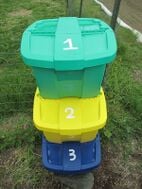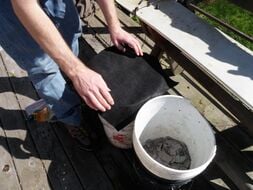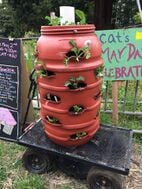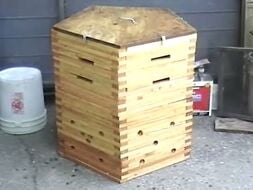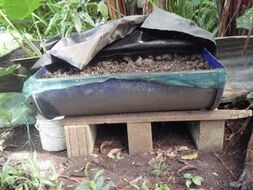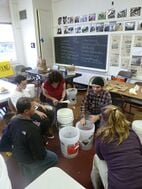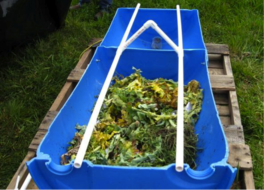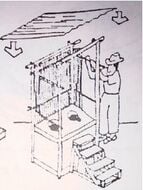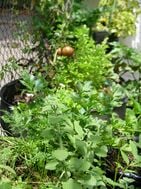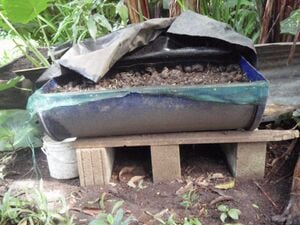
Vermicompost, vermiculture, or worm farming, is the utilization of some species of earthworm such as Eisenia fetida (commonly known as red wiggler, brandling, or manure worm), E. foetida, and Lumbricus rubellus to make Vermicompost (aka Worm Compost, Vermicast, Worm Castings, Worm Poop, Worm Humus or Worm Manure), which is a nutrient-rich, natural fertilizer and soil conditioner, which is the end-product of the breakdown of organic matter.
Unlike composting, worm farming can be carried out on the balcony of an apartment, in the basement of a house, or in a heated garage if the bin is suitable and it is well maintained to avoid odors. Worm bins also:
- can speed up the process by months[1]
- are often much smaller than compost bins
- can take pure kitchen waste, without needing garden waste or soil once the colony has been established
- can handle paper (e.g. paper with food on it, which can't be put out with paper recycling)
Vermiculture can be an especially useful practice in developing countries where fertilizer is harder to obtain. It can be used to convert animal waste, food scraps, and other dead organic matter into a nutrient rich fertilizer. This can ultimately be used to fertilize a home garden and produce a greater quality and quantity of food for the family.
History of Composting and Vermiculture[edit | edit source]
History of Composting[edit | edit source]
One can imagine that that the more nutrients a plant has, the healthier it is and the better it will grow. The healthier plant will produce more fruit. Modern science shows us how nutrients promote better plant growth, but in prehistoric times it was most likely an observation. If one puts a nutrient rich substance such animal manure in the soil next to a plant, it will promote a greater yield. Thus, the need to produce nutrient rich organic matter from animal manure, leaves, and other plant matter, was born.
It is hard to pinpoint the origin of composting because of its very long history most likely dating to prehistoric times. Some of the first written accounts of composting date to 3000 B.C where the use of manure as fertilizer is mentioned on clay tablets. Composting throughout history is documented in written works such as the bible, ancient Chinese writings, and the Bagavad Vita. Prehistoric farmers composted by mixing straw with animal manure. Ancient Greeks composted using straw from animal stalls. Native Americans and early European settlers enjoyed the benefits of mixing fish and organic matter to make a nutrient rich fertilizer for plants.[2]
In 1840, Justus Von Liebig published ORGANIC CHEMISTRY IN ITS APPLICATION TO AGRICULTURE AND PHYSIOLOGY. In this book, Liebig showed that plants absorb nutrients that are suspended in solution.[3] This disproved the theory that plants "eat" humus (nutrient rich organic matter) to gain their nutrients. Liebig's publication revolutionized the farming industry. It was much easier for farmers to apply chemical fertilizers rather that add composted material. These practices led to land degradation through erosion, insect infestation, and eutrophication of waterways by runoff. In 1940, Sir Albert Howard developed a composting method that involved specific ratios of carbon and nitrogen, 3 to 1 respectively. This was achieved by mixing three parts green matter such as plant leaves to one part brown matter such as animal manure.[4] Howard proved that compost was better for plant nutrient uptake than chemical fertilizers alone because compost improved soil aeration and water holding capacity which allowed for better nutrient uptake. Howard proved that compost was a natural way of producing plant fertilizer and that it was actually better for the plant. This inspired people to develop different methods of composing such as tumbling barrel composters and backyard composters. People began to compost at home to create a natural fertilizer for gardening. A study found that people are most likely to compost based on their attitude on what composting involves and their knowledge of composting.[5]
Howard showed that composting produced a valuable fertilizer, but other studies have shown that composting is a valuable way of reducing the amount of organic waste that is put into landfills. It is estimated that each person in the United States generates 2.6 pounds of organic waste per day.[6] A study done in the UK showed that 20% of biodegradable waste could be diverted from a landfill if 20% of the community would compost at home.[7] Due to economic and public health constraints, large scale composting operations didn't gain traction in Europe until the 1950's and in the United States until the 1980's.[8] New developments in composting inspired cities, farmers, and industries to compost on a large scale. Cities started to use composting in waste water treatment so that waste could be converted to fertilizer and not dumped into a landfill. A composting plant in Sweden would take waste and dewater it, mix it with shredded refuse, pulverize it, and allow it to compost. They would then use the compost as fertilizer.[9] In the last 20 years, composting has increased especially on a household scale due to its beneficial impacts on the environment.
History of Vermiculture[edit | edit source]

The Egyptians were one of the first cultures to recognize the soil amending properties of the earthworm. Under Cleopatra's rule, the removal of earthworms from Egypt was a crime that could have one killed.[11] Worms have been observed by such scholars as Aristotle and Charles Darwin as organisms that decompose organic matter into rich humus or compost.[12] It is believed that the mother of modern day vermiculture is Mary Appelhof. As a Michigan biology teacher, Appelhov wanted to continue composting in winter months even though she lived in a northern climate. She ordered worms from a bait shop nearby and set up one of the first indoor composting systems.[12] She found her composting system to be a great success. She published two brochures titled "Basement Worm Bins Produce Potting Soil and Reduce Garbage" and "Composting your Garbage with Worms". Her work was featured in a New York Times titled "Urban Composting: A New Can of Worms". This inspired many people to partake in vermiculture, especially urban apartment dwellers.[12]
Some of the advantages of vermicomposting over regular composting are that vermicomposting can be done indoors with relatively no negative effects, it is faster than regular composting, and it produces and overall better compost. A study showed that traditional composting it associated with elevated temperatures within the pile due to microbial activity. These high temperatures actually slow the composting process.[13] Vermicomposting produces little heat which does not slow the composting process. Vermicomposting has also been studied and implemented on a large scale. One study found that composting animal waste was a valuable way to produce food for other animals. Pig, cow, and chicken waste was composted and converted into worm biomass. This worm biomass was found to be a nutritious food stock for other animals.[14]
Biology of Worms[edit | edit source]
Vermiculture uses worms to break down organic matter into Compost. Compost is a rich fertilizer that can be added to soil to provide many benefits. The most common worm used in vermiculture is the red earthworm (Eisenia fetida). Worm anatomy and physiology is an integral part of the design of a vermicomposter so it will be discussed here. Other common earthworms can be used in vermiculture and they can be implemented into the system the same way as Eisenia fetida. Because of worms' similarities, the common earthworm (night crawler type) will be discussed here and will be related to E. fetida.
Biology[edit | edit source]
Worms are found throughout the world. They are small (10-300mm long) tube shaped organisms that live in or on top of the soil. Worms start their life as a cocoon deposited in the soil by parents. Worms can live from a few months to 10 years, but they usually do not reach the latter age because of environmental hazards they are exposed to. Some species of worms have the capacity to regenerate parts that are detached, although tests show this is an uncommon trait.[15] All earthworms have both male and female reproductive organs. These hermaphroditic digesters will mate at different times depending on their specific species and acclimation to their environment.[16] Worms mate both on the surface and in the soil, with the latter being most common. Once fertilized and grown, the worm will deposit the cocoon where environmental conditions are right in the soil.[15]
Worms have a relatively simple digestive system that runs along the length of their body. Organic matter is ingested at the front of the worm where the mouth is located. The organic matter is then passed through a gizzard there strong muscles contract and grind up the organic matter. Enzymes are then released by the stomach to break down organic matter and release energy that the worm can use. Worms have a symbiotic relationship with microorganisms in their digestive system. The microorganisms help the worm digest organic matter while the worm gives the microorganisms a place to live. In turn, both the microorganisms and the worm benefit from the relationship. Waste is excreted by the worm at the back where the anus is located.[15] The waste excreted by worms is called worm casts (vermicasts). Vermicasts contain more micro-organisms, inorganic materials, and organic matter in the form available to plants than regular soil.[15]
Earthworms are sensitive to pH. A study showed that E. fetida found in more acidic peats (3.6-4.2) burrowed less, respired less, and produced less castings.[17] The activities (metabolism, growth, reproduction, respiration) of earthworms are greatly influenced by temperature. These two factors can influence how fast a vermiculture system operates. Earthworms can be killed by extreme temperature such as extreme heat and extreme cold. They can also be killed by drying. Worms are usually found where there is much organic matter. Conversely, they are usually not found where there is little organic matter to be eaten. Worms can eat a wide variety of organic matter for food. In adverse conditions, they can even extract nourishment from soil for a short duration.[15]
Impacts of Worms on their Surrounding Ecosystem[edit | edit source]
Even though worms are relatively small and don't account for much of the biomass in an ecosystem, they can still have large impacts. There is still a lot about worms that is not known. In the book "The Biology of Worms" the authors call for much more research to be done.[15]
Benefits[edit | edit source]
There are many benefits of having earthworms in an ecosystem. Common earthworms (nightcrawler types) might be the "most efficient biological agents to be found anywhere in the world. They specialize in removing dead organic material from the surface of the land, greatly enriching it in the process, and then…carry the improved reside deep underground, right down amongst the roots of plants, where it is most needed."[18]
Earthworms have been shown to increase seed dispersal. A study showed a positive correlation between the number of earthworms present and the number of seedlings.[19] This study showed that earthworms inadvertently eat plant seeds. The worms continue to burrow through the soil as these seeds pass through their digestive system. The seeds are untimely excreted within the soil. Not only is this a great seed dispersal system for plants, the seeds are also excreted in a worm cast which is a nutrient rich substance for the seed. Worms have been found to be sensitive to pesticides and herbicides, and thus have been used as bio-indicators of healthy or poor soils.[20] This can be an easy way for farmers to assess the health of their soils. Another study showed that E. fetida can be used as a bio-indicator of high concentrations of heavy metals such as copper and lead in the soil.[21]
Earthworms have also been shown to increase bio-turbation. A study showed that earthworms take organic matter from the surface of the soil and migrate it to the upper soil horizons. This ultimately took nutrients such as N and P and put it proximal to plants roots, increasing the accessibility of nutrients to the plant.[22]
One of the most beneficial aspects of worms is the casts they produce. Worm casts (vermicasts/ worm poop/worm compost) are the feces of worms. Worm casts are high in nutrients such as NH4, accessible P and SO4, K, Ca, and Mg. Soil with worms also contained almost twice as much organic carbon.[23] Another study showed that worms casts stimulated plant growth by making nutrients more available and also by increasing the water holding capacity of the soil.[24] Worm casts increase the amount and accessibility of nutrients to the soil, the water holding content of the soil, and the amount of beneficial microorganisms in the soil.
Negative Effects[edit | edit source]
Earthworms have been shown to have a plethora of benefits. But, some of these characteristics make them bad for certain ecosystems. In the native northern hardwood forests of United States, earthworms are, in recent history (since last glacial period) an invasive species. These earthworms are introduced almost exclusively by human activity such as anglers dumping unused worms in waterways or on soil, bulk earth movement associated with construction and forestry road construction, and by vermiculturalists introducing them through compost. Although earthworms are great for plants, a study showed that invading earthworms were correlated with a loss of understory plant species, and increase is soil carbon loss, and their effect of nutrient cycling.[25] Northern hardwood forests have adapted to a slow organic decomposition rate and snow nutrient turnover. Earthworms are invasive in these ecosystems because they are very efficient and fast at decomposing organic matter and nutrient turnover and northern hardwood forests are not adapted to these conditions. A study showed that in just four years, an organic layer of 10cm was depleted in a hardwood forest in Minnesota.[26] The slow organic turnover in hardwood forests provides a sink for carbon. Thus, the faster decomposition of organic matter by invading earthworms has also been proposed as a possible driver of global climate change due to the release of this carbon from storage[25] .
There are ways people can stop this invasion, especially when it comes to vermicomposting. A study showed that some species of worms are less tolerant of cold weather. Of these species, E. fetida is a species that cannot tolerate cold temperatures, thus it will not be able to tolerate northern winters.[27] This study suggest that in cold climates where worms are known to be invasive (Northern Hardwoods), vermiculturist can freeze their worms for an extended time to kill them and mitigate the potential for invasion.
Biology of E. fetida[edit | edit source]

E. fetida, the worm most commonly used in vermiculture, have characteristics of common worms. They are epigian, meaning the spend most of their time above the soil. E. fetida is most commonly chosen as the worm used in vermicompost systems because of its ability to process organic matter rapidly. One study showed that the presence of E. fetida in manure increased overall microbial biomass and activity. Their presence also increased the overall fungal biomass and activity. Their presence also increased the diversity of both microbes and fungi. In this study, the rate of carbon loss was almost twice that where the worms were not present.[28] This shows that with E. fetida, decomposition happens almost twice as fast. Because of this property of fast decomposition rate, E. fetida is usually chosen as the worm for vermiculture because it reduces the time needed to make compost. E. fetida is also chosen for vermiculture because of its ability to break down cellulose. Cellulose is the most abundant polymer in nature and it is the largest component that enters terrestrial ecosystems. A study showed that the presence of E. fetida almost doubled the rate of cellulose decomposition.[29]
Design[edit | edit source]
One of the benefits of a vermicomposter is its relatively simple design. There are three main parts to a vermicomposter. There is the storage area where the worms and organic matter is stored, the organic matter (food scraps) and bedding for the worms, and lastly there are the worms.
Storage Area[edit | edit source]

Storage areas for vermicomposters are diverse and can be selected to meet the needs of the individual who is composting. The storage area's function is to contain the worms and organic matter to be composted. Ultimately, the only restriction is that it needs to keep your worms centralized. This is relatively easy because if you create an environment suitable for the worms they will be content living in any storage area. Some important things to consider are size, materials, and if one would like to build their own or purchase the storage area. If indoors, storage areas typically have a cover that reduces smells. If a cover is present, holes need to be installed to allow oxygen to enter the storage area. Holes should also be installed at the bottom of the storage area to allow excess fluid drainage to ensure proper moisture conditions inside the storage area.
If you'd like to make your own bin there are many designs that have already been implemented around the world. These can be adopted and altered to suit your own needs most appropriately:
- Worm Farming: a page with great information and three different designs.
- Barrel Design: from Costa Rica
- Kids' Worm Bin: made from cartons and small enough for urban living with a video demonstration
- Worm Bin for School: another barrel design from Humboldt County
- Barrel'o'fun:with detailed pictoral instructions
- CCAT's Vermicomposting Bin: a beautifully designed system for those looking to exercise their carpentry skills
- Shoebox- Sized Bin:another small-scale design
- Bucket Design: slightly less small-scale, higher capacity, stores under some sinks.
Typical storage bins for household use are storage totes, buckets, and trash bins. Others have constructed their bins out of wood or plastic. The bins should not contain chemicals that may leach into the compost such as those commonly found in Styrofoam. If the storage area is outside, the location of the storage area should be considered. Earthworms do not like extreme temperatures, so very sunny spots should be avoided.
Organic Matter and Bedding[edit | edit source]
Bedding is important for the system especially in the early stages. The bedding provides early habitat for the worms provides them with a food source early on. Bedding is typically composed of what earthworms would usually eat such as leaf litter, grass litter, and other dead organic plant matter. People have used non-traditional organic matter as well such as shredded paper and saw dust. The bedding must be moistened to assure proper environmental conditions of the worm.
Worms[edit | edit source]
Worms are an integral part of the composting system. Worms most commonly selected are E. fetida and E. foetida. The function of the worms is to convert organic matter into compost. Worms should be selected based on how much organic matter you wish to compost and how fast. Worms can eat roughly their body weight per week. This is a very crude estimate because so many factors can affect composting rate, but it can be used as a good estimate. Using this figure, if one produces 1kg of household food waste or other organic matter per week, they will then need round 1/8 kg of worms.
Construction and Operation[edit | edit source]
Construction[edit | edit source]
- The first step is to select a storage area. The first thing to consider is the size of your storage area. This depends on how much organic matter you will be composting, the amount of worms you have and how often you would like to switch storage areas. Your bin size should depend on these three things. Large amounts of organic matter per week will need larger areas. Longer time between bin changes will also require larger areas. Storage areas that are planned for household use should have a lid to help reduce smells. Bins should have small holes to allow adequate air flow and holes on the bottom to allow for excess fluid drainage.
- Once a storage area is obtained, puncture holes in the lid (if present) and bottom to allow airflow and fluid drainage. If composting in a house, the bin should be elevated to allow drainage of fluid. A set of bricks works nicely. You will also want to put something under the bin to catch fluid.
- The third step is to prepare the bedding for the worms. Once the bedding has been chosen (leaves, newspaper, sawdust), start by submerging it in water. Remove the bedding from the water and squeeze out the water. Then take the bedding and lay it in the storage area. There should be roughly 5 cm of bedding across the floor of the storage area. The bin is now ready for worms and composting.
Operation[edit | edit source]

- The first step in operating a vermicomposter is to introduce the worms to the system. Remember that this should be scaled to the amount of organic matter you will add weekly. Note that you worms will reproduce and become larger, ultimately eating more organic matter. Thus, it is best to start with a smaller amount of worms to ensure that there will be enough organic matter. Put your worms on your already prepared bedding. The worms can survive on the bedding alone for a short duration, so adding organic matter isn't crucial within the first couple of hours. Once introduced, the worms will want to explore their new habitat. If composting in your house, watch the bin closely first 24 hours to ensure no worms escape the bin. Within 24-48 hours the worms should become acclimated to their new habitat and will no longer try to escape.
- The next step is to add organic matter. Add the organic matter to be composting by placing it on top of the worm bedding. New organic matter should not be added until previous organic matter is almost all composted. There are few things that earthworms cannot eat.
Suitable organic matter that can be added are
- coffee grounds with filter and tea bags
- all fruits and vegetables, including rinds and cores
- egg shells
- leaves and grass clippings
- beans, rice, and other cooked grains
- bread and crackers

Items that should be avoided are
- meat
- bones
- foods high in oils and fats, such as grease from meat
Maintenance[edit | edit source]
A vermicomposter requires little maintenance. A long a food is added when previously added organic matter is almost composted the system should require little maintenance. Check on the composter weekly. The system is running properly if the worms are within the organic matter and bedding. If the worms are trying to escape this is an indicator that the conditions in the bedding and organic matter are not suitable for the worms. Once the bin is full or you wish to use the compost, the vermicompost will have to be harvested. The vermicompost is ready to be harvested when it has an earthy smell and no organic matter is visible.
Harvesting[edit | edit source]

Handsorting, vertical sorting, and horizontal sorting are all ways of harvesting vermicompost. Some ways are faster, but involve more work while others are slower but involve little work.
Handsorting - This is done by dumping the vermicompost onto a sheet where the worms can be sorted out. Once dumped, worms can be picked out of the vermicompost and put into the new composter. Sift through the vermicompost removing all worms and worm eggs (cocoons). The eggs are white/tan and pea sized. They can be easily recognized and removed. A bright light can be focused on the pile to concentrate the worms toward the center of the pile if desired. This method is more labor intensive but it is fast compared to vertical and horizontal sorting.
Vertical sorting – Vertical sorting uses an alternating bin and allows the worms to sort themselves from the vermicompost. This works best if bins are being used for the storage area because they are easily stacked. To sort vertically, obtain a second bin and prepare it as you would if you are starting a new vermicomposter. Remove the lid of the bin currently in use and place the new bin on top of vermicompost. Place new organic matter on top of the bedding in the new vermicomposter. Over time as the worms run out of food in the old composter, they will migrate to the new bin via the drainage holes in the bottom of the new bin. This way or sorting requires minimal work because they worms sort themselves, but it does require more time.

Horizontal sorting – Horizontal sorting is similar to vertical sorting but it does not require a second storage area. To sort horizontally, partition your bin into areas. Add organic matter in a linear fashion. As you add your new organic matter across the bin, the worms will migrate with it. Eventually, you can harvest the vermicompost at the other side of the bin as your worms migrate to the fresh organic matter. This system requires minimal work sorting, but it does require more time as opposed to hand sorting.
Using the Vermicompost[edit | edit source]
Vermicompost can be used immediately or can be stored for later. Vermicompost can be mixed with soil as a soil amendment to increase nutrients, water holding capacity, and aeration. Vermicompost can be used as top dressing for household plants to increase the nutrients available to them. Vermicompost can be seeped in water to extract the nutrients and then nutrient water can be applied to plants. Vermicompost can also be used as a mulch.[30]
Troubleshooting[edit | edit source]
A vermicomposter should require little maintenance, but problems can arise. Consult the following table for troubles. Remember that worms will want to stay in the bin if conditions are right for them. If worms are trying to escape conditions in the composter should be altered.
| Problem | Cause[31] | Solution |
|---|---|---|
| Foul odor | Too much air | Make smaller holes |
| Not enough air | Make bigger holes | |
| Too much organic matter | Add less organic matter per feeding | |
| Dying worms | Too wet | Make more drainage holes |
| Too dry | Mist compost to add water | |
| No food | Add food | |
| No bedding for worms | Harvest compost and add bedding | |
| Extreme temperatures | Moderate Temperatures | |
| Fruit Flies | Air holes too big | Make smaller air holes or bury organic matter under bedding |
Impacts[edit | edit source]
Good[edit | edit source]

Easy access to nutrient rich compost could have very large impacts on families, especially in developing countries. With access to vermicompost, families have access to nutrient rich fertilizer that will promote better plant growth in family gardens. Vermicompost will also make it easier for families to grow gardens because of its beneficial properties. Family gardening provides families with food security and better food nutrition. Food security increases because families have direct access to food that can be harvested on a daily basis. Nutrition of the family increases because plants are more nutritious due to the vermicompost.[32]
With earth population recently reaching 7 million and continuing to rise, a large problem is feeding all of these people with a limited amount of agricultural land. Because of this problem, urban gardening is becoming ever more important. In Kibera, Nairobi, urban gardening has been shown to increase nutrition and also increase family income by money generated from selling excess produce. Families have been able to increase their income by 5-6 USD per week.[33] Vermiculture is an easily made fertilizer that could be used in urban agriculture to boost nutrition and crop yields, potentially increasing family income.A study done showed that in India and other locations, vermiculture and vermicompost have the potential of completely replacing chemical fertilizers.[34] This could have a large impact because much of today's synthetic fertilizers are made using large amounts of fossil fuels.
A large impact that vermicomposting can have is reducing the amount of organic waste that is sent to landfills each year. An Australian statistic states that about two thirds (62%) of all waste landfilled in 06-07 in Australia was organic waste.[35] With vermiculture, much of this waste can be composted and turned into vermicompost. This has the potential to increase the longevity of landfills and reduce the costs associated with handling municipal solid waste.
Bad[edit | edit source]
One of the bad things about vermiculture is that it may introduce earthworms where they are not a native species. This may cause problems that are similar to the earthworm invading Northern hardwood Forests of the United States. To avoid this, worms do not like extreme temperatures or conditions. Thus, if living in a cold climate, worms can be killed by freezing them over winter. Worms can also be killed in a hot climate by heating up the compost in the sun or drying out the compost. The worms will dry out and die if moisture is not adequate. Ultimately, worms will want to be conserved and given to neighbors for use.
Dissemination[edit | edit source]
There is a plethora of information regarding vermicomposting on the internet, in magazines, and in books. Cities are holding events where they teach citizens about vermicomposting and its benefits because it can reduce the amount of waste that ends up in the landfill, thus reducing the costs that are associated with trucking and moving the waste. Ultimately this saves the city money, but it is better for the environment as well. This technology is mostly being implemented and used in developed countries on a household scale. Vermicomposting has the most potential in developing countries because of the benefits that are associated with vermicomposting. Below is a list of links to more information about vermiculture for further reference.
The most common earthworm species used for vermicomposting[edit | edit source]
- Red wigglers (Eisenia fetida): Red wigglers are the most popular vermicomposting worm because they are easy to care for and breed quickly. They are also very efficient at breaking down organic matter.
- European nightcrawlers (Eisenia hortensis): European nightcrawlers are another popular vermicomposting worm. They are larger than red wigglers and can tolerate a wider range of temperatures. However, they are not as prolific breeders as red wigglers.
- African nightcrawlers (Eudrilus eugeniae): African nightcrawlers are a good choice for vermicomposting in tropical and subtropical climates. They are very heat-tolerant and can process a wide variety of organic materials.
- Blueworms (Perionyx excavatus): Blueworms are another good choice for vermicomposting in tropical and subtropical climates. They are very efficient at breaking down organic matter and can be used to compost a wide variety of materials, including manure, food scraps, and garden waste. Other earthworm species that can be used for vermicomposting include:
- Dendrobaena veneta
- Lumbricus rubellus
- Dendrobaena hortensis When choosing earthworms for vermicomposting, it is important to select a species that is well-suited to your climate and the type of organic material you plan to compost. It is also important to note that some earthworm species are invasive and should not be released into the wild.
Related projects[edit | edit source]
See also[edit | edit source]
External links[edit | edit source]
- Wikipedia:Vermiculture
- Founder vermicultivation Thomas J. Barrett
- Wikia:Permaculture:Worm compost
- City Farmer, Canada's Office of Urban Agriculture - Composting With Red Wiggler Worms.
- Klicitat County - Worm Bin Plans (OSCR Jr.)
- The Worm Digest
- Amy Stewart | Blog | Worm Blog | Worm PDF | Books
- Working WormsDIY Worm Farming.
- vermiculture discussion at permies.com
References[edit | edit source]
- ↑ http://working-worms.com/content/view/38/60/
- ↑ http://web.archive.org/web/20170723073333/http://web.extension.illinois.edu:80/homecompost/history.html
- ↑ Liebig, Justus Von. ORGANIC CHEMISTRY IN ITS APPLICATION TO AGRICULTURE AND PHYSIOLOGY, Published by John Owen, 1843.
- ↑ Fitzpatrick, G. E, Worden, E. C, Vendrame, W. A, (2005). Historical Development of Composting Technology during the 20th Century. HortTechnology, Jan-Mar 2005, Vol. 15 Num. 1, pp 48-51.
- ↑ Edgerton, E, Mckechnie, J, Dunleavy, K, (2009) Behavioral Determinants of Household Participation in Home composting Schemes. Environment and Behavior, Mar 2009, Vol. 41 Num. 2, pp 151-169.
- ↑ Raloff, J, (1993) Cleaning up Compost. Science News, Jan-1993, Vol. 143 Num. 4, pp 56-58.
- ↑ Smith, S. R, Jasim, S, (2009) Small-scale home composting of biodegradable household waste: overview of results from a 3-year research programme in West London. Waste Management and research, 2009, pp 941-950.
- ↑ Blum, B, (1992) Composting and the Roots of Sustainable Agriculture. Agricultural History, Spring – 1992, Vol. 66 Num. 2, pp 171-188.
- ↑ Hovsenius, G, (1975) Composting and use of Compost in Sweden. Journal (Water Pollution Control federation), Arp – 1975, Vol. 47 Num. 4, pp 741-747.
- ↑ http://www.wormplicity.com/wp-content/uploads/2012/04/Worms-Eat-Our-Garbage-Classroom-Activities-for-a-Better-Environment.jpg
- ↑ (http://greenliving.nationalgeographic.com/ancient-composting-20323.html)
- ↑ 12.0 12.1 12.2 http://www.gardenguides.com/121248-history-vermicomposting.html
- ↑ Frederickson, J, Butt, K. R, Morris, R. M, Daniel, C, (1997) Combining Vermiculture with Traditional Green Waste Composting Stsyems. Soil Biology and Biochemistry, 1997, Vol. 29 Num. ¾, pp 725-730.
- ↑ Edwards, C. A, Lofty, J.R, (1977) Biology of Earthworms, Chapman and Hall Ltd, London, UK. pp 68-220.
- ↑ 15.0 15.1 15.2 15.3 15.4 15.5 Edwards, C. A, Lofty, J.R, (1977) Biology of Earthworms, Chapman and Hall Ltd, London, UK. pp 68-220.
- ↑ http://working-worms.com/content/view/47/75/
- ↑ Satchell, J. E, Dottie, D. J, (1984). Factors Effecting the Longevity of Earthworms Stored in Peat. Journal of Applied Ecology, Vol. 21 Num. 1, pp 285-291.
- ↑ http://working-worms.com/content/view/38/60/
- ↑ Willems, J. H, Huijsmans, K. G. A, (1994). Vertical Seed Dispersal by Earthworms: A Quantitative Approach. Ecography, Jun 1994, Vol. 17 Num. 2, pp 124-130
- ↑ Daugbjerg, H, Hinge, J, Jensen, J. P, Sigurdardottir, H, (1999) Earthworms as Indicators of Cultivated Soils? Ecological Bulletin, 1998, Num. 39, pp 45-47.
- ↑ Christopher, J. P, (2001) A Standardized Soil Ecotoxicological Test Using Red Worms (Eisenia fetida). The American Biology Teacher, Nov.-Dec. 2001, Vol. 63 Num. 9, pp 662-668.
- ↑ Scheu, S, (1987) The Role of Substrate Feeding Earthworms (Lumbricidae) for Sioturbation in a Beachwood Soil. Oecologia, 1987, Vol. 72 Num. 2, pp 192-196.
- ↑ Ganeshamurthy, A. N, Manjaiah, K. M, Subba Rao, A, (1998) Mobilization of Nutrients in Tropical Soils Through Worm Casting: Availability of Macronutrients. Soil Biology and Biochemistry, Oct 1998, Vol. 30. Num. 13, pp 1671-1676.
- ↑ Zaller, J. G, Arnone III, J. A, (1999) Interactions between Plant Species and Earthworm Casts in a Calcareous Grassland under Elevated CO2. Ecology, Apr 1999, Vol. 80 Num. 3, pp 873-881.
- ↑ 25.0 25.1 Bohlen, P. J, Scheu, S, Hale, C. M, McLean, M. A, Migge, S, Groffman, P. M, Parkinson, D, (2004) Non-Native Invasive Earthworms as Agents of Change in Northern Temperate Forests. Frontiers in Ecology and the Environment, Oct – 2004, Vol. 2 Num. 8, pp 427-435.
- ↑ Hale, C. M, Frelich, L. E, Reich, P. B, (2005) Exotic European Earthworm Invasion Dynamics in Northern Hardwood Forests of Minnesota, USA. Ecological Applications, Jun – 2005, Vol. 15 Num. 3, pp 848-860.
- ↑ Greiner, H. G, Stonehouse, A. M. T, Tiegs, S. D, (2011) Cold Tolerance among Composting Earthworm Species to Evaluate Invasion Potential. The American Midland Naturalist, Sept – 2011, pp 349-357.
- ↑ Aira, M, Monroy, F, Dominguez, J, (2007) Eisenia Fetida (Oligochaeta: Lumbricidae) Modifiers of the Structure and Physiological Capabilities of Microbial Communities Improving Carbon Mineralization During Vermicomposting of Pig Manure. Microbial Ecology, Nov 2007, Vol. 54 Num. 4, pp 661-672.
- ↑ Aira, M, Monroy, F, Dominguez, J, (2006) Eisenia Fetida (Oligochaeta: Lumbricidae) Activates Fungal Growth, Trigering Cellulose Decomposition during Vermicomposting. Microbial Ecology, Nov 2006, Vol. 52 Num. 4, pp 738-747.
- ↑ Kimball, S. L, Doeksen, G. A, Vermicomposting – Composting with Worms. Brochure BAE-1742, Division of Agricultural Sciences and Natural Resources, Oklahoma State University.
- ↑ Monroe, G, Manual of On-Farm Vermicomposting and Vermiculture. Organic Agriculture Centre of Canada, http://web.archive.org/web/20170331001853/http://www.organicagcentre.ca/DOCs/Vermiculture_FarmersManual_gm.pdf
- ↑ Marsh, R, (1998) Building on Traditional Gardening to Improve Household Food Security. Food Nutrition and Agriculture, 4-14.
- ↑ Pascal, P, Mwende, E, (2009) A Garden in a Sack: Experiences in Kibera, Nairobi. Urban Agriculture Magazine, Jan 2009, Num. 21.
- ↑ Sinha, R. K, Herat, S, Valani, D, & Chauhan, K. (2009). Vermiculture and sustainable agriculture. American-Eurasian Journal of Agricultural and Environmental Sciences, 2009, pp 1-55.
- ↑ Australian Government, National Waste Policy Fact Sheet, Department of the Environment, Water, Heritage and the Arts.
